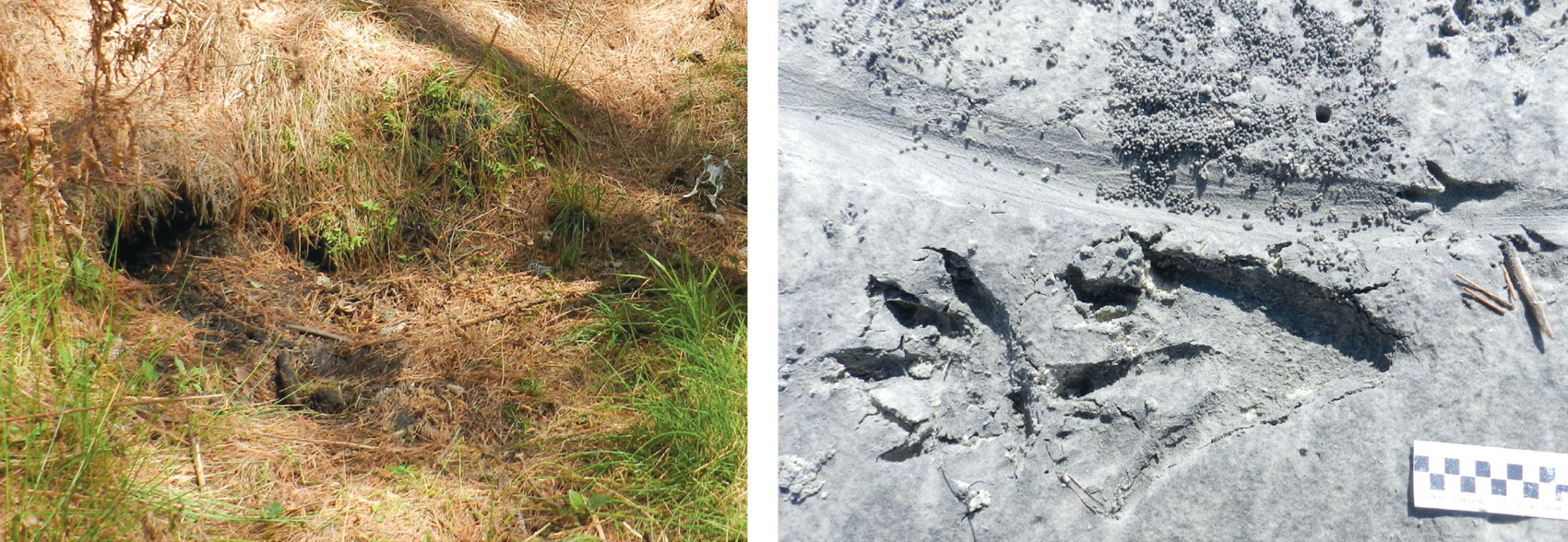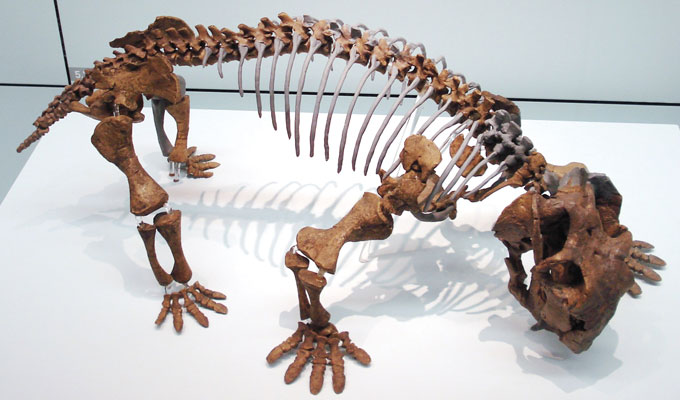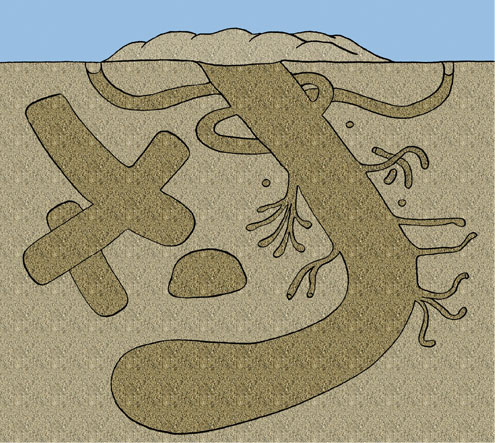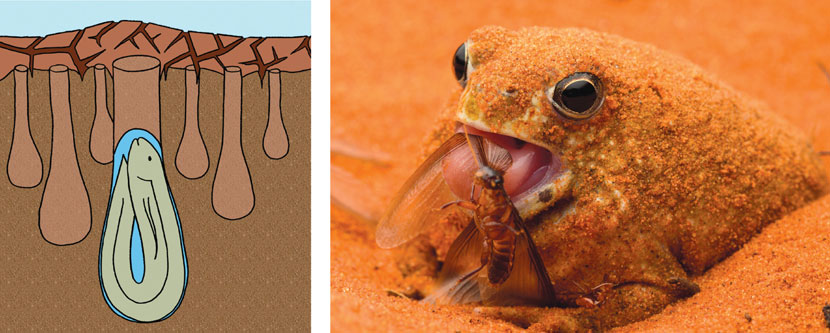The Evolutionary Advantage of Burrowing Underground
By Anthony J. Martin
Many animals dig dens for protection from weather, disasters, or predators, and this behavior may have allowed some species to survive when others have died out.
Many animals dig dens for protection from weather, disasters, or predators, and this behavior may have allowed some species to survive when others have died out.

The alligator den had a big surprise for us. Its occupant was hidden inside a dark space down an inclined tunnel, its entrance denoted by a meter-wide, half-moon-shaped hole in the middle of a pine forest. The alligator’s presence was verified only by a rumbling growl, followed by an openmouthed hiss. The burrow chamber added resonance to these sounds, turning an already spooky situation into a downright portentous one. This sonic combo, intended as a warning, worked quite well in that respect, persuading all of us to issue a collective “Whoa!,” take a few steps back, and assess our situation.
It was yet another moment in my teaching career when I wondered how many other professors must concern themselves with apex predators showing up in their classrooms. Nonetheless, on the plus side, if any of my students had been bored with the course material, they were now very much engaged, perhaps even wondering whether this alligator-related incident would be covered on the next exam.

Photograph courtesy of Ruth M. Elsey/Louisiana Department of Wildlife and Fisheries.
At that moment, my undergraduate students, a faculty colleague, and I were deep in the interior of St. Catherines Island on the Georgia coast and on our sixth day of a spring-break field course trip in March 2013 to the Georgia barrier islands. St. Catherines is an undeveloped island used mostly for scientific research and was the fifth island we had visited thus far on our trip. My colleague was geographer Michael Page, who had joined us the previous day; he had been on St. Catherines with me once before to map alligator dens in July 2012. We documented dozens of dens next to water bodies, many of which hosted alligators. In some instances, we affirmed the identity and purpose of these big holes by witnessing alligators swimming or otherwise dashing into them. With other dens, we spotted tracks and tail-drag traces crisscrossing their entrances, effectively telling us not to get any closer.
This den, though, had no such fresh warning traces outside of it, meaning that the contentious alligator inside had been there for a while. When the growl-hiss greeting was broadcast from the den, Michael was standing above and behind the den, whereas I was almost directly in front. We had already seen about 10 alligator dens that morning, all of them empty. That fact lulled us into a false sense of security, a confirmation bias that affected our better judgment when approaching this one. My prejudice was further bolstered by a memory of this very same burrow, which had had absolutely no sign of an alligator in it when Michael and I had examined it the previous summer. During that visit, we photographed and measured each den we encountered, as well as recorded their locations with a global positioning system (GPS) unit. But we remembered this specific den because it had the largest entrance of any we had seen, at more than a meter wide and 40 centimeters tall. It was big enough that I could have crawled into it, had I been so stupid.
Size aside, what really made this den memorable was its location, which was in the middle of the woods. As everyone likely knows, alligators normally live in water. Yet no lakes, ponds, or streams were within sight, and the forest floor around the den was carpeted with dry pine needles. Still, this den and several others nearby were located on the bank of what used to be a human-made canal. Thus Michael and I quite reasonably surmised that the canal had been submerged sometime in the past—perhaps decades ago—which encouraged alligators to move into the neighborhood and dig dens. Later, drought and other changes in local hydrology must have altered the water supply in this area. So the alligators moved somewhere else.
In this instance, I had just begun explaining to our students how this was yet another example of an abandoned den made by previous generations of now-dead alligators. This meant it only served as the trace of a former alligator in what used to be an aquatic environment that later turned into a terrestrial environment. A fine hypothesis it was, but one so rudely proven wrong by the live, two-meter-long, body-armored, and bad-tempered saurian residing in its so-called abandoned home.
To my students’ credit, they had started us on the path to falsifying the notion that this big hole was gator-less. Once I spotted the den, I greeted it like an old friend, enthusiastically striding toward its opening before delivering my little lecture to the assembled group. A few students stood back, impressed by the size of the hole and staring into its underground darkness, a seemingly bottomless pit of mystery. The whirring of zoom lenses and digitally rendered shutter sounds behind me told me they were taking plenty of pictures. I was pleased that they found this burrow as interesting as I did.
Suddenly, I was jarred out of my educational reverie when one of students said, “I see teeth in there.”
“Teeth?” I asked.
“Yeah,” she said, and others nodded agreement.
“What kind of teeth?” I asked. Like a typical paleontologist, I was thinking of a disembodied skull or jaw, instead of a breathing animal bearing (or baring) those teeth.
“I don’t know. Could it be a snake?”
“Sure, that’s possible.” I had seen alligator dens with snakes in them before. Also, unlike certain fictional archaeologists, I like snakes and relished the thought that one might be in the burrow. “But you probably wouldn’t be seeing its teeth,” I said, as I became more confused about this unexpected shift in the lesson plan. Puzzled, I stepped closer to the entrance—eliciting the startling growl-hiss.
I looked up at Michael. The disbelief probably still registered on my face, but my expression also must have wordlessly asked him, “What do we do now?”
With his GPS unit in one hand, Michael smiled, and with barely suppressed glee at the absurdity of our predicament he said, “Guess we have to mark that one as occupied.”
This alligator incident marked the beginning of an idea for me that had far wider implications than field-trip hijinks and close encounters with potentially dangerous foes. This idea stems from what we know of how alligators descended from a lineage of crocodilians and their kin that were alive more than 200 million years ago, when dinosaurs were still stomping, fighting, nesting, eating, mating, peeing, pooping, and otherwise leaving their mark on the world. Yet when a meteorite smacked into the Earth about 66 million years ago, this disaster and other problems caused a devastating worldwide crisis for life everywhere, whether in the oceans or on land. As a result, all of the dinosaurs (that did not have the good sense to be birds) died, leaving only their bones and traces.
Meanwhile, alligators and other crocodilians carried on, as did a number of turtles, lizards, snakes, fishes, amphibians, insects, earthworms, mammals, and other animals we now accept as normal parts of our modern world. What did they have in their genetic or behavioral repertoire that could have helped them survive, that the dinosaurs did not have?
Let’s think about birds first. As everyone with a five-year-old child knows by now, not all dinosaur lineages went extinct, as some evolved into modern birds. The first birds descended from theropod dinosaurs about 160 million years ago; most theropods were two-legged carnivores, such as cinema stars Velociraptor and Tyrannosaurus. So far, paleontologists have discovered about 40 species of feathered theropods, enough that we can now confidently assert that most (if not all) theropod dinosaurs from the Late Jurassic and Cretaceous periods (from about 160 to 66 million years ago) were feathered. (This discovery also means that the Jurassic Park films, including Jurassic World, should have been rated R, because all of the raptors and other theropods portrayed in them were naked.) Feathered and flighted avian dinosaurs somehow survived a mass extinction that took out all of their relatives 66 million years ago.

Photographs courtesy of the author.
Interestingly, on that very same island of St. Catherines and others off the Georgia coast, my students and I had witnessed interactions between birds and crocodilians that made us feel like we were back in the Cretaceous. Some island interiors held ponds with small islands, where tall wading birds—such as storks, herons, and egrets—built their nests on tree branches, well above land and water surfaces. Their nests were protected by not just the parent birds, but by what seemed like unlikely allies: alligators. Because alligators were swimming in the ponds and staying nearby in dens, they served as convincing deterrents to raccoons or any other mammals that thought they could raid a bird’s nest and enjoy scrambled eggs for breakfast. This deal, however, was a Faustian bargain.
As a Mafia-like payment, if a hatchling fell out of the nest and onto an island or into a pond, this hapless baby bird became an easy meal for any alligator lucky enough to be in the right place at the right time. Yet this brutal compensation is a much better deal for parent birds than having an entire egg clutch consumed by ruthless raccoons. Hence these birds and alligators may have coevolved their respective behaviors, with mutual arrangements struck by their ancestors millions of years ago.
So now let’s focus on the alligators, and specifically those on St. Catherines Island. At the time I visited there with my students in 2013, the alligators had been enduring a drought for the previous few years, part of a more severe overall pattern caused by less rainfall on the island during the past several decades. This meant the normal habitats for alligators—freshwater ponds and other wetlands—had shrunk, leaving them with fewer places to stay and make a living by killing fish and other animals. One might expect that such low water supplies and dire conditions would have left alligator skeletons strewn throughout a desiccated landscape. Nonetheless, they were still very much present, active, and continuing to survive by spending more time in dens. Alligators likely dug these big burrows along the edges of ponds, canals, and other wetlands during times of plentiful water; the dens remained once the wetlands vanished and were succeeded by grasslands and forests. Yet alligators could still move back into these dens; some of the burrows they were able to use intersected the groundwater table below the surface.

Wikimedia Commons
Thus these underground “wetlands” served the purpose of keeping alligator skins moist, while conferring many other benefits. For instance, given that these dens held fresh water on an island where such supplies had become more precious, they also provided a tempting source of water for other animals, such as mammals and birds. Their thirst then neatly delivered the alligators’ groceries to them. All the alligators had to do was wait just within burrow entrances and snatch whatever looked large enough to eat. My students and I found evidence of this ambush strategy on that same field trip: Two dens that had fresh carcasses outside of them. One den had just the remains of a vulture, its bones and feathers stuck in the entrance, whereas another had the remains of a raccoon about a meter away from its opening. A meter farther from the raccoon, though, was another dead vulture; the still-red bloodiness of both bodies suggested they had been killed in quick succession. So it was easy to think how the raccoon, once dispatched and only partially eaten, would have attracted the attention of vultures, supplying the den-dwelling alligator with a two-course meal.
Similarly, older and long-abandoned dens in parts of the island had bone collections adorning their fronts, usually consisting of a jumbled mix of deer and raccoon parts. All of this trace evidence told us the alligators could switch from aquatic to terrestrial predation if necessary, like a shark deciding it was going to turn into a lion. This surprising behavioral transformation and adaptability in alligators was made possible through their dens, which during times of environmental change became all-purpose hunting lodges.
In addition to keeping their occupants wet and enabling them to ambush prey, dens served another important purpose: protection. For example, drought conditions on St. Catherines bolstered the likelihood of lightning-caused fires racing through forests and grasslands alike. Sure enough, one such fire in the summer of 2012 scorched part of St. Catherines. This same place had enough alligator dens in it that the island manager, Royce Hayes, had nicknamed it the “Nerve Center.” He was amazed to find fresh alligator tracks on top of a wildfire ash layer, made by alligators that apparently stayed safe and secure in their dens during the fire, and then emerged for a little walkabout.

Image courtesy of the author.
If this use of alligator dens doesn’t impress as a form of protection, then think of alligator babies. That’s right: cute little alligator babies, which easily fit on the palm of an average adult human hand when newly hatched. Only later do they grow up to become monsters—in much the same way that human children eventually turn into teenagers. Despite being so adorable, a baby alligator is regarded as an appetizer by nearly everything bigger than it is—including other alligators—regards it as an appetizer. Hence these little tykes need defending, which is partially provided by their overprotective mothers, but also by dens. Alligator mothers stay with their offspring for as long as two years after they hatch, and if dens are nearby, they will use these not only as places with plenty of fresh water (which baby alligators need), but also as places for hiding the kids from trouble.
I have seen (or caused) the latter behavior many times. My walking near a den or a small pond with baby alligators sets off their alarm calls, which consist of a series of high-pitched grunts. These noises send a clear signal that you could die, because a big momma gator is close by and now knows her babies are in danger. Once the babies sound the alarm, the mother either crawls or swims into the den headfirst, leading the way for her wee ones. Still grunting, they align and scramble together toward and into the den to be with mom. By then, she will have turned around in a large chamber very close to the burrow entrance, ready to defend her offspring against anything that might try to bring them harm, human or otherwise. In several instances, I have seen the mother’s massive head just behind the den entrance, almost daring you to get closer and test her evolutionary legacy.
Dens protect alligators of all ages in another way, which is from cold winters and hot summers. As most people know, alligators are cold-blooded, or ectothermic. This means they cannot regulate their own body temperatures and instead have to rely on their surrounding environment to keep themselves within a range that allows for life to go on. For alligators, the ideal temperature is about 27 to 32 degrees Celsius; any higher or lower than this range, and they have problems. Surprisingly, though, alligators can live farther away from the equator than any modern crocodilians. In North America, these big reptiles can live as far north as North Carolina, and how they accomplish this trick is by using dens.
These burrows bestow a Goldilocks effect by averaging the temperatures of cold winters and hot summers, making it just right all year. On the Georgia coast, where summer temperatures can easily exceed 32 degrees and water temperatures approach those of hot tubs, alligators duck into dens to cool down. Conversely, I have also seen large alligators out sunning themselves on near-freezing days in December, implying that a den was close by and kept them warm enough to get out for a little solar therapy. Human cavers similarly recount the mollifying effects of being underground, enjoying what feels like cool and warm cave interiors during summer and winter, respectively, when the cave is actually the same temperature all year.
All of this brings us back to the unexpected burrow occupant my class and I encountered, while neatly answering the perfectly reasonable scientific inquiry: “What the heck was a large adult alligator doing in the middle of a forest?”
Remember how I said we were visiting in March? The timing of our trip suggests this big critter had likely entered the den sometime during the winter, when temperatures dipped low enough and long enough that it needed to stay sufficiently warm to survive. We were there at the cusp of spring on the Georgia coast, when outdoor temperatures were edging closer to the alligator heaven of 27–32 degrees instead of the crystalline cold of winter. Yet the weather in early March, with average lows around 10 degrees, was still not quite warm enough to coax this one out of its temporary refuge. What was the year-round average temperature in this part of Georgia? More like 20 degrees, meaning that if you lived underground all year, there would be no need to set a thermostat, as it would stay that way all of the time. While the weather outside dipped below freezing, this big alligator and many of its compatriots had probably overwintered in dens that remained close to 21 degrees all winter. What cavers and other underground enthusiasts have learned through experience, alligators figured out through natural selection.
Given the multifaceted uses of dens, it is now easy to see how a simple statement can be made about the role dens have played in the evolutionary history of alligators: no dens, no alligators. This bold statement is backed up by a quick look at alligators’ living close relatives, such as the Chinese alligator (Alligator sinensis), which dig extensive tunnels in riverbanks to make dens, as well as other crocodilians that burrow to survive. Indeed, more than half of all crocodilian species (14 out of 23) dig and live in burrows during times of environmental stress, such as droughts. Then consider how many salamanders, frogs, toads, turtles, lizards, snakes, and other ectothermic animals live at far higher latitudes than alligators. Nearly all of these animals accomplish this feat by spending winters underground or otherwise protected. Even self-heating endotherms—namely, birds and mammals—their chances of freezing or sweltering by seeking shelter below ground surfaces. In short, these animals can’t move up unless they get down.
These insights we gain from studying alligators’ dens suggest that at least some of the ancestors of modern-day alligators and crocodiles, and perhaps their bird companions, likely used burrows to get past the environmental hazards of the past. For an example of burrowing birds, just think of those charming, family-oriented, unstoppable krill-eating marchers, penguins. All penguin species live in the Southern Hemisphere and all polar bears live in the Northern Hemisphere, meaning that the only place you would ever see a polar bear eating a penguin is in a badly managed zoo. Yet despite the stereotype of penguins living only in Antarctica and huddling together for warmth there, most species actually live in a wide variety of environments. Moreover, more than half of all penguin species make and live in burrows, which they use for—you guessed it—raising young, protecting themselves and their chicks from predators, and avoiding the harsh conditions of their outside environments. (Incidentally, the oldest known fossil penguins date from about 62 million years ago, just after the extinction of their nonavian dinosaur cousins). So alligator dens are by no means a unique instance of burrows allowing their makers to survive long enough to pass on genes to the next generation, while also enabling gene-passers to do more than just that. For many animals, burrows save and extend lives, while also serving as the places animal families call home.

Wikimedia Commons
Keeping this “burrow equals survival” theme in mind, and just in case you are still enthralled with the alligator-crocodile-bird success story of out-surviving nonavian dinosaurs, realize that this is not nearly as impressive as knowing how burrows contributed to the lineage you see reflected in your mirror every morning. Many mammals are fabulous burrowers, and this ability goes back even further into the geologic past than alligators, crocodiles, and birds. Ancestors of these furry vertebrates, called mammaliaforms, evolved toward the end of the Triassic period about 220 million years ago, which was just after the start of the dinosaurs. The ancestors of mammaliaforms, synapsid reptiles, originated even farther back in time, during the Carboniferous period, more than 300 million years ago.
Once they evolved, synapsids, such as Dimetrodon, were terrifically successful, adapting to and dominating land environments throughout the Permian period (about 300 to 250 million years ago). Sadly (for them), nearly all went extinct at the end of the Permian, a time sometimes called “the Great Dying” because of how extreme global warming and other factors caused 95 percent of all species to wave goodbye to their evaporated gene pools. Notice I said “nearly,” which implies that a few made it into the next period, the Triassic. From these surviving synapsids, mammals evolved, and their descendants somehow made it past another mass extinction at the end of the Triassic, then were a constant presence throughout the heyday of the nonavian dinosaurs—surviving, but not necessarily thriving. Then, once the dinosaurs died out in the next mass extinction at the end of the Cretaceous period, about 66 million years ago, mammals really took off. This success led to our own primate lineage, some members of which learned how to control fire, track game animals, identify useful plants, map the heavens, and, finally, flirt with emoticons.

Jasmine Vink
Burrows do not just start with synapsids and mammals, though, but also go much farther back in time as a tool for survival. For instance, during the Devonian and Carboniferous periods (420 to 300 million years ago), lungfishes and amphibians were also digging down and living in burrows. Skeletons of these animals have even been found in their fossil burrows, connecting this behavior with modern-day burrowing lungfishes, as well as with salamanders, frogs, toads, and other amphibians that do the same. Burrowing behaviors enable these water-dependent animals to live in deserts or avoid the worst effects of droughts. Once self-buried, some lungfishes, frogs, and toads can stay underground and become torpid for months or years, popping out once water becomes more plentiful. Granted, lungfishes and amphibians fossilized in their burrows did not survive whatever fate entombed them. Yet enough of their relatives did and then bequeathed burrowing abilities to future generations, which is all that matters in evolutionary terms. Moreover, all of these animals descended from water dwellers that flopped, slithered, crawled, or otherwise landed on foreign shores. How did these aquatic animals manage to overcome the desiccating effects of land environments after emerging from the water? Burrows certainly would have helped.
The long history of these burrowing invertebrates completely altered global environments and even affected climate.
Much later, vertebrate burrows of all sizes and shapes also provided microhabitats for plenty of other species, which today is best exemplified by gopher tortoises and their homes. These seemingly unimpressive tortoises, which do not get much bigger around than a typical dinner plate, are incredible diggers, hollowing out tunnels that can be more than 10 meters long and 3 meters deep to keep themselves out of harm’s way. Their lengthy tunnels can also have nearly 400 species cohabitating in them, from insects to snakes, with at least a few of these species having evolved their own specialized niches over many generations of burrows. The underground “rain forests” of biodiversity in gopher tortoise burrows hint at the importance of vertebrate burrows for maintaining life’s balance in many ecosystems today.
But enough about vertebrates: What about the real overlords of the Earth, such as worms and insects? How about other spineless animals that have adapted to nearly every terrestrial and marine environment? Do modern invertebrates live in burrows, and did their ancestors also live in burrows? Of course they do and did, as can be attested by anyone who has owned a yard, strolled through a park, walked along seashores, or sat on an ant nest. Many of these burrows left a remarkable record of the evolutionary history of animals going back more than 550 million years, as they made transitions from surface living to deep burrowing, and as they moved from deep-sea environments to shallower sea bottoms, and from the sea to freshwater ponds and streams, and from water to land. The bigger picture behind these everyday observations of many holes in the ground, however, is that the long history of these burrowing invertebrates completely altered global environments, from the deepest sea to the highest mountains, and even affected the atmosphere and climate. In short, the entire surface of our planet is built upon one big complex and constantly evolving burrow system, controlling the nature of our existence.
This article is excerpted and adapted from The Evolution Underground, by Anthony J. Martin, published by Pegasus Books, 2017 © Anthony J. Martin. All rights reserved. Reprinted with permission.
Click "American Scientist" to access home page
American Scientist Comments and Discussion
To discuss our articles or comment on them, please share them and tag American Scientist on social media platforms. Here are links to our profiles on Twitter, Facebook, and LinkedIn.
If we re-share your post, we will moderate comments/discussion following our comments policy.